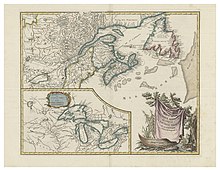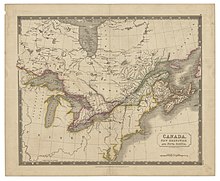Atlantic Canada, also called the Atlantic provinces (French: provinces de l'Atlantique), is the region of Eastern Canada comprising the provinces located on the Atlantic coast, excluding Quebec. The four provinces are New Brunswick, Newfoundland and Labrador, Nova Scotia, and Prince Edward Island.[1] As of 2021, the landmass of the four Atlantic provinces was approximately 488,000 km2 (188,000 sq mi), and had a population of over 2.4 million people. The provinces combined had an approximate GDP of $121.888 billion in 2011.[2] The term Atlantic Canada was popularized following the admission of Newfoundland as a Canadian province in 1949.
Atlantic Canada Provinces de l'Atlantique (French) | |
|---|---|
 Atlantic Canada (red) within the rest of Canada | |
| Country | Canada |
| Composition | |
| Most populous municipality | Halifax |
| Area | |
| • Total | 488,000 km2 (188,000 sq mi) |
| Population (2021) | |
| • Total | 2,409,874 |
| • Density | 4/km2 (10/sq mi) |
History


The Atlantic Provinces are the historical territories of the Mi'kmaq, Naskapi, Beothuk and Nunatsiavut peoples.[3][4][5][6] The people of Nunatsiavut are the Labrador inuit (Labradormiut), who are descended from the Thule people.[6] Acadia, a colony of New France, was established in areas of present day Atlantic Canada in 1604, under the leadership of Samuel de Champlain and Pierre Dugua, Sieur de Mons.[7] The French would form alliances with many indigenous groups within Atlantic Canada, including the Mi'kmaq of Acadia, who joined the Wabanaki Confederacy, important allies to New France.[8]
The first premier of Newfoundland, Joey Smallwood, coined the term "Atlantic Canada" when the Dominion of Newfoundland joined Canada in 1949.[9] He believed that it would have been presumptuous for Newfoundland to assume that it could include itself within the existing term "Maritime provinces," used to describe the cultural similarities shared by New Brunswick, Prince Edward Island, and Nova Scotia, which entered Confederation during the 19th century (New Brunswick and Nova Scotia were founding members of the Dominion of Canada in 1867, and Prince Edward Island joined in 1873).[10]
Geography
Although Quebec has a physical Atlantic coast on the Gulf of St. Lawrence, it is generally not considered an Atlantic Province; instead, it is classified as part of Central Canada, along with Ontario.[1]
Atlantic and Central Canada together are also known as Eastern Canada. Atlantic Canada includes a section of the Appalachian Mountains known as the Appalachian Uplands.[11] In each Atlantic province, Upland regions have been divided into three highland areas. The mountain range results in coastal regions being fjorded. Some areas contain glaciofluvial deposits.[12][13]
The following tables use Statistics Canada's 2021 census data.
Municipal geography
Provincial geography
| Province | Land area (km2) | References |
|---|---|---|
| New Brunswick | 71,248.50 | [62] |
| Newfoundland and Labrador | 358,170.37 | [63] |
| Nova Scotia | 52,824.71 | [64] |
| Prince Edward Island | 5,681.18 | [65] |
Demographics
The following tables provide 2021 census figures for "Metropolitan Areas" (built from entire municipalities) and "Population Centres" (limited to actual continuously-built-up areas) in Atlantic Canada. The list includes communities above 15,000, by Metropolitan Area population, or 10,000 by Population Centre population.
Municipal populations
Provincial populations
| Province | Population | Population density (people per km2) | Reference |
|---|---|---|---|
| New Brunswick | 775,610 | 10 | [62] |
| Newfoundland and Labrador | 510,550 | 1 | [63] |
| Nova Scotia | 969,383 | 18 | [64] |
| Prince Edward Island | 154,331 | 27 | [65] |
Economy
Atlantic Canada's primary natural resource industries include fishing, hydroelectricity, forestry, and mining.[66] The Atlantic provinces contribute to around 75% of Canada's fish production, with many coastal communities primarily dependent on fisheries.[67] The access point for many of such fisheries being the Gulf of St. Lawrence and the Atlantic continental shelf.[68]
Nova Scotia produces 75% of Canada's gypsum. Salt and iron is also mined in the Atlantic provinces.[69][66]
See also
- Acadiensis, scholarly history journal covering Atlantic Canada
- Atlantic Provinces Chambers of Commerce
- Atlantic Northeast
References
Further reading
- Hamilton, William Baillie (1996), Place names of Atlantic Canada, University of Toronto Press, ISBN 0-8020-0471-7
- MacEachern, Alan Andrew (2001), Natural selections: national parks in Atlantic Canada, McGill-Queen's University Press, ISBN 0-7735-2157-7
- Martinez, Andrew J; Martinez, Candace Storm (2003), Marine Life of the North Atlantic: Canada to New England, Aqua Quest Publications, ISBN 1-881652-32-7
- Prieur, Benoit (2005), Atlantic Canada, Ulysse Travel Publ, ISBN 2894647239
External links






